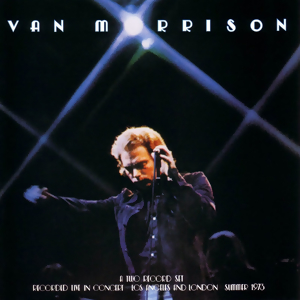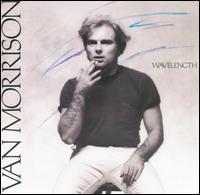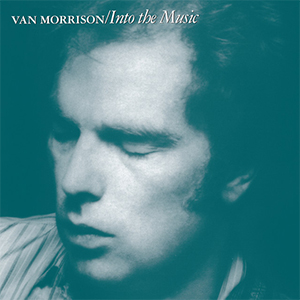
Hard Nose the Highway is the seventh studio album by Northern Irish singer-songwriter Van Morrison, released in 1973. It is his first solo album since his 1967 debut Blowin' Your Mind! to contain songs not written by Morrison. A cover version of the song "Bein' Green", usually associated with Kermit the Frog, is included, as is a take of the traditional song "Purple Heather". The album also contains the single "Warm Love," a fan favourite.

It's Too Late to Stop Now is a 1974 live double album by Northern Irish singer-songwriter Van Morrison. It features performances that were recorded in concerts at the Troubadour in Los Angeles, California, the Santa Monica Civic Auditorium, and the Rainbow in London, during Morrison's three-month tour with his eleven-piece band, the Caledonia Soul Orchestra, from May to July 1973. Frequently named as one of the best live albums ever, It's Too Late to Stop Now was recorded during what has often been said to be the singer's greatest phase as a live performer.

Wavelength is the tenth studio album by Northern Irish singer-songwriter Van Morrison, and was released in the autumn of 1978. The album has a different musical sound from his previous albums, leaning towards a pop rock sound with prominent electric guitars and synthesizers. Wavelength was Morrison's best selling album at the time of the original release. Mick Glossop, Bobby Tench and Peter Bardens were given credit for special assistance in production.

Common One is the twelfth studio album by Northern Irish singer-songwriter Van Morrison, released in 1980. The album was recorded over a nine-day period at Super Bear Studios, near Nice, on the French Riviera. Its title is in the lyrics of the song "Summertime in England": "Oh, my common one with the coat so old and the light in her head".

Inarticulate Speech of the Heart is the fourteenth studio album by Northern Irish singer-songwriter Van Morrison, released in 1983. Morrison said he arrived at the title from a Shavian saying: "that idea of communicating with as little articulation as possible, at the same time being emotionally articulate". As his last album for Warner Bros. Records, he decided to do an album which had more than the usual complement of instrumental tracks. As he explained in 1984, "Sometimes when I'm playing something, I'm just sort of humming along with it, and that's got a different vibration than an actual song. So the instrumentals just come from trying to get that form of expression, which is not the same as writing a song." Although not expanded upon, of note is that a special thanks is given to L. Ron Hubbard in the liner notes. The reissued and remastered version of the album contains alternative takes of "Cry for Home" and "Inarticulate Speech of the Heart No. 2".

Beautiful Vision is the thirteenth studio album by Northern Irish singer-songwriter Van Morrison, released in February 1982. It continued Morrison's departure from R&B at the time, instead favoring Celtic folk and American jazz in its music. As with many of Morrison's recordings, spirituality is a major theme and some of the songs are based on the teachings of Alice Bailey. Other songs show Morrison's Celtic heritage and reminiscence of his Belfast background.

Poetic Champions Compose is the seventeenth studio album by Northern Irish singer-songwriter Van Morrison, released in 1987 on Mercury Records. It received generally positive reviews from critics, most of whom viewed it as adequate mood music.

The eighteenth studio album Irish Heartbeat by Northern Irish singer-songwriter Van Morrison is a collaboration with the traditional Irish musical group the Chieftains, released in 1988. It was recorded at Windmill Lane Studios in Dublin, Ireland, and reached number 18 in the UK album charts.

Avalon Sunset is the nineteenth studio album by Northern Irish singer-songwriter Van Morrison. It was released in 1989 by Mercury Records to both commercial and critical success. In 2008, Avalon Sunset was reissued and remastered, featuring an alternate take of "Whenever God Shines His Light", and a version of "When the Saints Go Marching In" with additional lyrics by Morrison.

Hymns to the Silence is the twenty-first studio album by Northern Irish singer-songwriter Van Morrison. It was his first studio double album. Morrison recorded the album in 1990 in Beckington at The Wool Hall Studios and in London at Townhouse and Westside Studios.

Days Like This is the twenty-third studio album by Northern Irish singer-songwriter Van Morrison, released in 1995. It is a diverse group of songs offering a variety of moods and styles. It ranked No. 5 on the UK album charts and was nominated for the Mercury Prize.

Back on Top is the twenty-seventh studio album by Northern Irish singer/songwriter Van Morrison, released in 1999 by Point Blank. It reached the Top Twenty in seven countries, building on the success of 1997's The Healing Game.

The Philosopher's Stone is a compilation album by Northern Irish singer-songwriter Van Morrison released in 1998.

"Summertime in England" is the longest song on Northern Irish singer-songwriter Van Morrison's 1980 album, Common One, and is approximately fifteen minutes long. Although the album on which the song appeared was not critically or commercially successful, the song would be performed by Morrison in concert for almost two and one-half decades, taking on new meaning when performed live. A truncated version of the song with an early fade-out was also released as the B-side of the 1983 single "Cry for Home".

"Bright Side of the Road" is a song written by Northern Irish singer-songwriter Van Morrison and included on his 1979 album Into the Music. It was also one of the outtakes that made up the 1998 compilation album, The Philosopher's Stone. As a single "Bright Side of the Road" was released in September 1979 and charted at No. 48 in the Netherlands, No. 63 in the UK and just outside the Billboard Hot 100 in the US at No. 110. In 2020, the song reached its highest radio airplay chart position in Ireland, peaking at #2.

"Cleaning Windows" is a song written by the Northern Irish singer-songwriter Van Morrison, recorded on his 1982 album Beautiful Vision.

"Real Real Gone" is a hit single written by Northern Irish singer-songwriter Van Morrison and included on his 1990 album Enlightenment. It has remained a popular live performance tune and Morrison has included it on the set lists at many of his concerts since releasing it.

Live at Montreux 1980/1974 is the first official DVD by Northern Irish singer-songwriter Van Morrison. It was released on 16 October 2006. The films consist of two separate performances by Van Morrison at the Montreux Jazz Festival in Switzerland. It was certified gold in May 2007 and platinum in June 2009.

Live at the Grand Opera House Belfast is a live album by Northern Irish singer-songwriter Van Morrison, released in 1984. It was recorded from four live shows in March 1983 at the Grand Opera House, Belfast, Northern Ireland. The album was composed of songs from Morrison's last four recordings. It is the second live album Morrison released, following 10 years after It's Too Late to Stop Now.

"Dweller on the Threshold" is a song written by Northern Irish singer-songwriter Van Morrison and first released on his 1982 album Beautiful Vision. It was released as a single on the B-Side in 1982 with the instrumental "Scandinavia" as the "A" side. Another release in 1984 had a live version of "Dweller on the Threshold" as the A-Side.



















